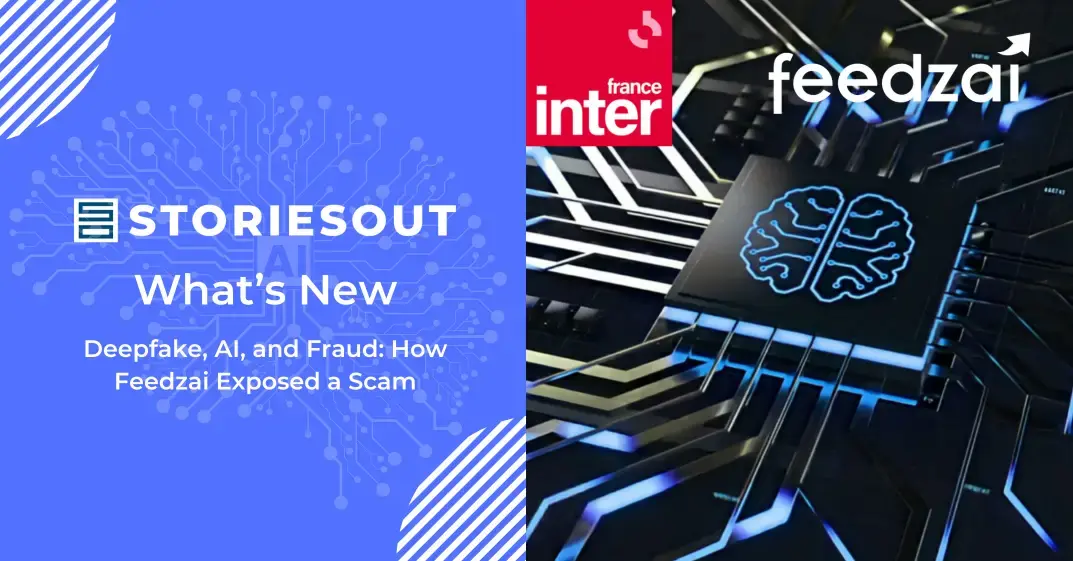We never expected to assist the General Manager of a client company in such a situation. Michèle Hallak, General Manager France of Feedzai, was the target of an online scam attempt using AI technologies, specifically one called deepfake.
What happened? How did we turn this situation into a communication opportunity that led to a testimony on a program from France’s leading radio station? Here’s the full story.
AI, Deepfake, and Fraud
The work we do for Feedzai typically focuses on its core business and is part of a broader brand awareness and press relations strategy. Feedzai is a fintech company that provides services to financial institutions, helping them detect and prevent fraud in real time through AI-based solutions. Feedzai also helps these institutions remain compliant with national and international regulations, such as detecting money laundering and organized crime activities.
However, in this case, AI was used in an entirely different way—to try and scam a company specialized in fraud prevention.
What Is a Deepfake?
A deepfake is an AI-based technology that can modify or generate images, videos, or sounds with hyper-realistic quality, replacing one face or voice with another. The term is a blend of “deep learning” and “fake.”
How does it work?
Deepfake technology relies on deep learning algorithms, particularly neural networks like GANs (Generative Adversarial Networks):
- One network (the generator) creates a modified image.
- Another network (the discriminator) evaluates whether the image looks real.
- Both networks improve iteratively, refining the fake until it becomes almost indistinguishable from reality.
These programs have legitimate applications, such as de-aging actors, recreating performances without requiring additional shooting in the :Film and entertainment industry. Voice cloning and generating synthetic yet convincing speech is also an trending use of such features.
However, deepfake technology is also widely used in cybercrime and disinformation, facilitating identity theft, fake news production, and manipulation campaigns.
Scamming a Fintech That Fights Scams?
Summer 2024. Michèle Hallak receives a WhatsApp message from someone who appears to be her CEO, inviting her to join a video call via a provided link. During the call, she sees the CEO’s face speaking on screen but hears no sound. Then, she receives a voice message. The CEO’s voice instructs her to prepare a financial transfer as part of an audit.
The problem? It wasn’t Nuno Sebastião, the real CEO of Feedzai—it was scammers using AI tools to replicate his identity.
The fraud attempt is quickly uncovered, the process raised some disturbing questions. Why were these communications happening outside of official company channels? Something felt off—was it really his voice and face?
After all, the scammers were targeting the General Manager of a company whose core business is detecting financial fraud.
Ultimately, the scam fails.
From Incident to France Inter: StoriesOut’s Expertise
At StoriesOut, we learned about this unusual incident during our regular discussions with Feedzai. The idea quickly emerged to pitch this story to media contacts, whether in specialized fintech press or mainstream outlets.
Although Feedzai’s communication strategy is mostly B2B, an AI-powered scam attempt on a fraud-detection fintech had strong media potential.
And it worked: Anaëlle Verzaux, a journalist at France Inter, was working on a report about the increasing use of AI-driven cyber scams and their growing capabilities. Our pitch caught her attention, and Feedzai’s General Manager shared her experience in the program Interception, France’s leading radio documentary show.
Conclusion
Is this a happy ending? Maybe not entirely. Feedzai was still targeted by a sophisticated fraud attempt. However, in the end, this incident found a positive outcome by reinforcing Feedzai’s media presence.
More importantly, it strengthened the company’s credibility in the sensitive field of financial fraud prevention—especially against emerging AI-based scams.




